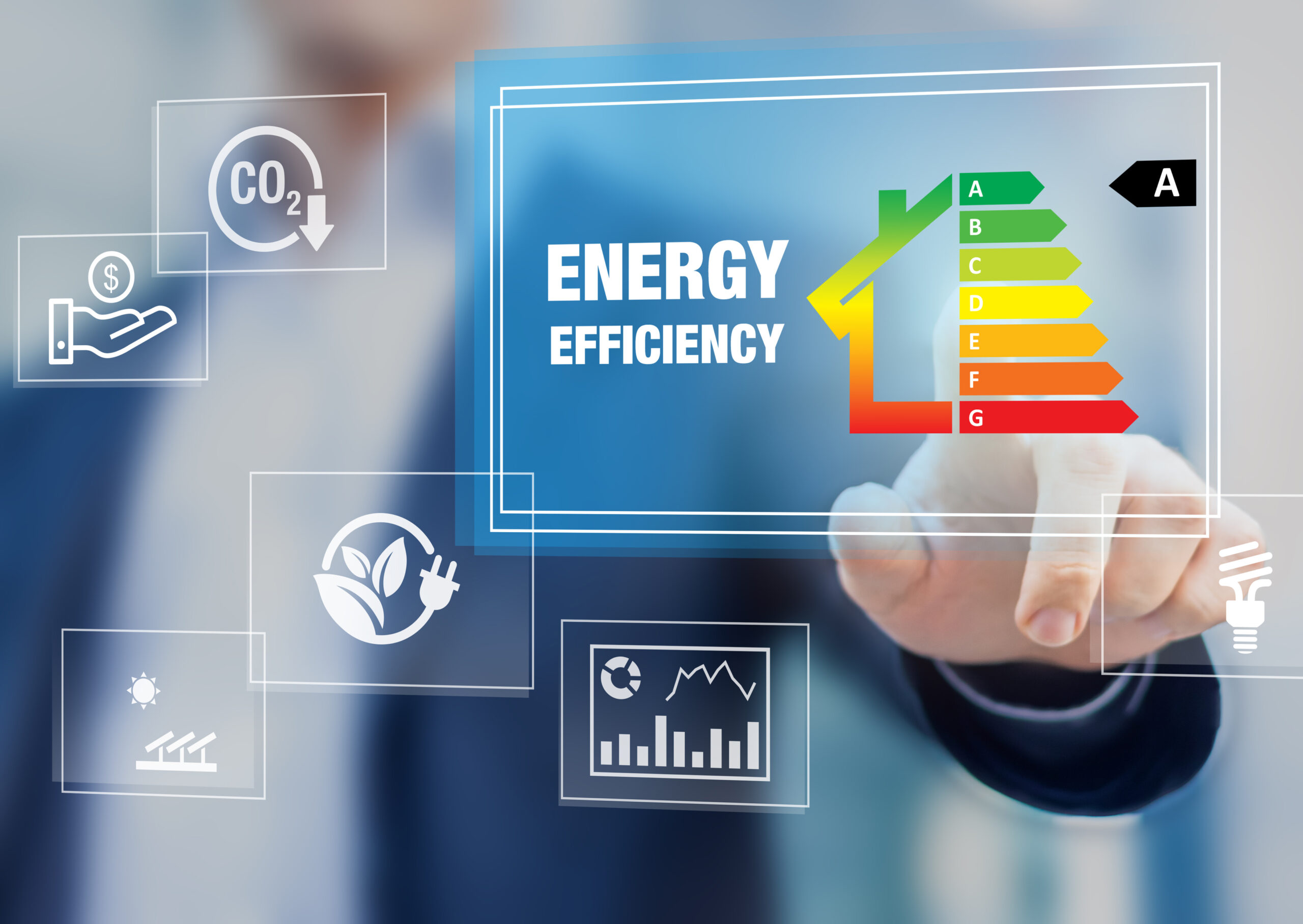
by Francisco Sayu | Aug 30, 2022 | Community, Electrification, Focus on Energy, Sustainability
Last month, I joined the Citizens Utility Board of Wisconsin in a virtual discussion about energy costs in the state. I discussed strategies to address rising energy costs during the panel, including energy efficiency and beneficial electrification. The panel focused on real-world actions residents can take to reduce their energy burden. You can watch the webinar replay by clicking on this link. Now, I want to talk about the resources we have to support individual efforts to fight soaring energy costs through energy efficiency. In particular, I want to talk about the Focus on Energy® Program. (Focus).
What do I mean by energy efficiency, and why should you care? Energy efficiency is the use of less energy to produce the same result. For example, a light-emitting diode (LED) lightbulb produces the same amount of light as an incandescent lightbulb using only 15 percent of the energy needed for the incandescent light because LED lights waste less energy in the form of heat. Energy efficiency is important because less energy saves you money on utility bills.
Most homeowners, renters, and businesses in Wisconsin can access resources – such as free Energy Saving Packs – and financial incentives to improve the energy efficiency of their homes and businesses through the Focus program. Focus is Wisconsin’s energy efficiency and renewable resource program that operates on behalf of 107 utilities. Since 2001 the program has saved Wisconsin residents over $1 billion.
Last spring, the Public Service Commission (PSC) made decisions regarding the overall policies and priorities for the next phase of the Focus program. Wisconsin law requires the PSC to review energy efficiency and renewable energy programs every four years. You can read the minutes of the PSC meeting here.
In summary, the PSC provided the following directions for the next four years (period from 2023 to 2026):
- Focus should play a more significant role in cost-effectively reducing carbon emissions. The next four years should serve as a transitional period during which the program continues emphasizing energy savings while progressing toward a transition to a greater emphasis on reducing carbon emissions.
- Focus shall not claim savings from fuel switching from unregulated fuels to electricity.
- Focus shall use the next four years as a transitional period to position the program to take on a more significant role in promoting beneficial electrification statewide.
- Focus shall develop and maintain a menu of options for voluntary utility programs to be shared with participating utilities.
- Focus shall maintain its current level of support for utility demand response programs.
- The Focus program should continue to offer income-qualified programs and coordinate with the Department of Energy weatherization program to further fill potential gaps in its low-income offerings, including community-based pilot(s) in targeted communities. The Focus Program Administrator shall convene a stakeholder group that includes community-based organizations that work with marginalized communities to address barriers to outreach and participation.
RENEW submitted comments to the PSC supporting the alignment of Focus with emissions reduction goals to lower the state’s dependence on imported fuels and support renewable energy development. You can read RENEWS’s comments on the Focus Quadrennial Planning Process here.
I will write in the future about resources to help you save money through beneficial electrification. Stay tuned!

by Francisco Sayu | May 24, 2022 | Electrification, Home, Sustainability
Co-author: Jenna Greene
Early April 2022, two people were seriously injured in an explosion caused by attempting to light a propane furnace in their Marinette County home. Approximately 253,000 (primarily rural) households in Wisconsin use propane to heat their homes, putting public safety at risk and creating greenhouse gas (GHG) emissions that negatively impact human health. In addition, propane is currently the most expensive fuel type for Wisconsin residents. Air-source heat pumps can be a safe, efficient, and affordable alternative to propane heat. Wisconsin needs policies, programs, and incentives that accelerate this transition for rural customers.
An air-source heat pump (ASHP) is an electrically powered heating and cooling device that moves heat, rather than generating it, to provide comfortable building temperatures. ASHPs operate “in reverse” in the summer to provide cooling (similar to a refrigerator). Cold-climate air source heat pumps have made significant technological advances in recent years; today, ASHPs can operate in temperatures as low as -22 degrees Fahrenheit. Some local Wisconsin residents and nonprofit organizations are already switching to ASHPs for heating and cooling.
Heating homes with fossil fuels create emissions that impact human health and contribute to climate change – 8% of greenhouse gas (GHG) emissions in Wisconsin come from the residential sector. Climate change threatens the economy in many ways, including increased flooding and storm damage, altered crop yields, lost labor productivity, and strained energy systems. Wisconsin’s electric grid is increasingly powered by renewable energy sources like solar and wind. Transitioning away from propane heat will increasingly reduce GHG emissions.
In 2021, Wisconsin imported 41,000 barrels of propane – valued at more than four million dollars. Spending money on imported energy resources weakens local economies and burdens household budgets. Many Wisconsin residents feel the effects of rising fossil fuel costs, with propane projected to be the most expensive fuel source in 2021-2022. Transitioning to air-source heat pumps can lower annual heating and cooling costs and free Wisconsinites from the volatility of imported fossil fuels.
ASHPs provide safe, efficient, and affordable home heating and cooling. Electricity is generated off-site and delivered to homes, which dramatically lowers the safety risk to families from on-site propane combustion. High-efficiency heat pumps can convert one British Thermal Unit (BTU) of electricity into three BTUs of heating or cooling – significantly more efficient than gas furnaces at most temperatures. ASHPs are also cost-effective compared with propane use. ASHP adopters can save up to $750 per year on heating and cooling costs. We need financing mechanisms to allow households and businesses to finance energy efficiency retrofits and ASHP installations with affordable upfront payments.
Many rural Wisconsin households use propane or heating oil to heat their homes which is expensive, puts people at risk, and sends millions of dollars out of state each year. Wisconsin utilities, policymakers, and Focus on Energy should expand programs to transition households from propane heating to efficient electric heating, saving people money, reducing hazards, and improving health outcomes in rural communities.
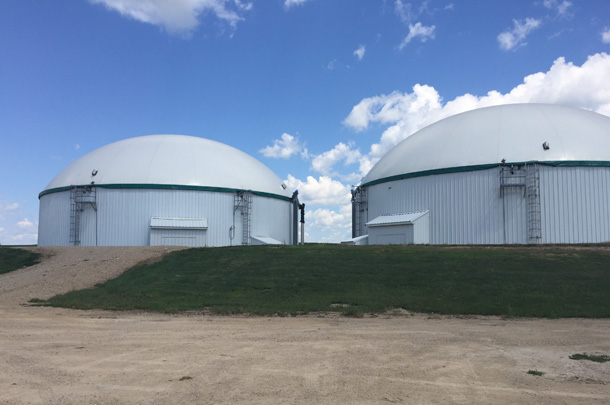
by Guest Blog | Apr 13, 2022 | Biogas, Renewables, Sustainability
Digestion of manure is, on paper, a relatively simple process. Similar to how a cow digests food, digesters further break down manure, capture methane, purify the gas and then convert it to pipeline-grade renewable natural gas (RNG).
Investors of all backgrounds have been touring dairy farms in the U.S. about RNG projects. I’ve heard stories with comments being made such as, “all your nutrient challenges will be gone,” to “we’ll pay you big money for your manure,” to “let’s be in partnership in this project.”
As a former owner of digester facilities, I can tell you that each project is a unicorn. How you bed your cows, frequency, method of manure spreading, and other aspects are just the tip of the iceberg of how farm practices impact the financial outcome of RNG projects.
Incorrect assumptions of owners/investors:
- The stuff coming out the back end is worth money
- Operations and management can be done with a few people
- It’s predictable
- This is a pot of gold at the end of a rainbow
Let’s dig a little deeper into each of these points.
The stuff coming out the back end is worth money.
The effluent does have nutrient value, and it is carbon-based. If separated, the liquid is easy enough to apply. The solids are commonly used as animal bedding, the base for compost, or spread on fields. Additional cost factors come in with the solid not being an easy form to spread on fields. Also, a watershed may require the removal of solids, which can be an added cost for transportation and negatively impact the project’s carbon intensity (CI) score.
Operations and management can be done with a few people
These facilities require people with specific knowledge. At first glance, the facilities are comprised of pipes, pumps, and poop. But there are by-products generated from manure –hydrogen sulfide and ammonia. Those two gasses deliver quite a punch to the equipment.
It is predictable
The aforementioned hydrogen sulfide and ammonia will humble even the best maintenance plan. Additionally, if manure is piped underground, it will require regular jetting due to buildup.
This is a pot of gold at the end of a rainbow.
RNG projects can be attractive financially, thanks to the Low Carbon Fuel Standard (LCFS) in California and Renewable Identification Numbers (RINs) at the federal level. Many factors can influence the actual income, primarily based on the CI score of a project, as mentioned earlier with farming practices and trucking costs. Historically, costs for maintenance have been underestimated. Equipment will break, and spare parts will be needed to keep projects running smoothly. Remember, if you’re not producing gas, you’re not making money.
Most large farming operations have already or are actively considering a biogas facility. The larger the number of cows, the better a project will pencil out. There are still plenty of opportunities for medium to smaller size farms to create a cluster project. These will depend on proximity to a pipeline.
Being mindful of these common misconceptions will put your team on the right track to a successful project. A legislative effort is underway for Wisconsin farm operations to increase access to the pipeline, therefore making projects more accessible. Click here to learn more about this.

Jessica Niekrasz
Principal
Clean Fuel Connects
Email Jessica Niekrasz
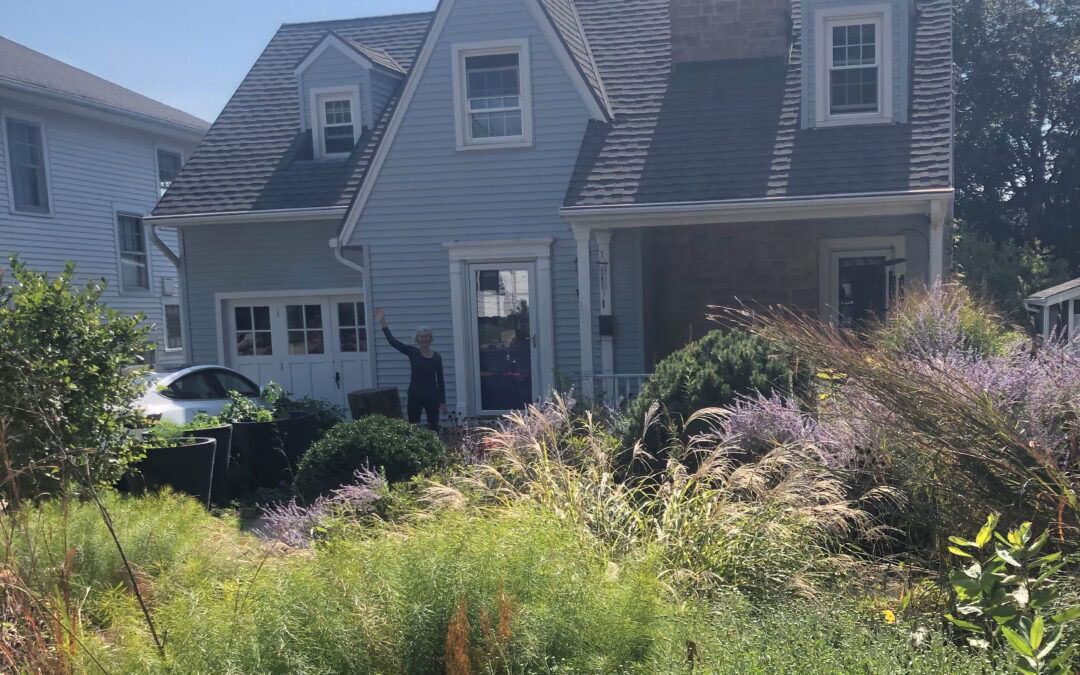
by Guest Blog | Nov 24, 2021 | Community, Focus on Energy, Home, Renewables, Solar, Sustainability
Beneficial electrification discussions often revolve around transportation electrification, specifically how electrifying vehicles can reduce emissions and offer cost savings for consumers. However, an under-discussed and equally important part of beneficial electrification is the building sector. At 24% direct emissions, the building sector comprises the largest end-use emissions in Wisconsin. Read further to learn about Susan Millar’s journey towards electrifying her home, including her installation of an air-source heat pump for greater heating and cooling energy efficiency.
The companies, technologies, and programs endorsed in this blog are not necessarily recommended or endorsed by RENEW Wisconsin. The following information and personal experience is illustrative of the process to electrify a residential property in Wisconsin.
Are you wondering how to convert an older single-family home with a forced hot-air heating system, a gas water heater, and a gas stovetop from gas and electric to electric-only? I have done that with a 90-year old house on the near west side of Madison. And because it took a fair amount of time, I am sharing the process I used. Before describing this process, I provide important context.
Context for Transitioning to All-Electric
- “Natural” gas is fossil gas. It must, and will, be phased out over time as our society gets more serious about reducing climate-warming emissions. In some municipalities, bans on gas in new construction are already in place.
- Air source heat pumps (ASHPs) are the energy-efficient electric-powered alternative to gas heating systems. ASHPs both heat and cool your house (no separate AC device needed). They have a high coefficient of performance, so while they use electricity, the amount is much less than, say, what an electric space heater or traditional AC unit uses. See, for example, this video description of ASHPs.
- Air source water heaters (also called “hybrid” water heaters) work the same way as ASHPs except they exchange air with your basement instead of the air outside. They are far more efficient than traditional electric water heaters.
- Our state’s Focus on Energy program provides rebates for air-source air and water handling systems. The installers handle this process. (I am not sure of the size of these rebates.)
- MG&E’s monthly (gas) service charge is $22. If you stop your gas service and start it again, they will bill you for monthly service charges for up to 12 months prior to the time you start again. That is, you cannot stop your gas service except for, say, the month of January without paying for up to 12 months of service.
- If you have not yet, or cannot install, solar panels on your roof, you can sign up for MGE’s shared solar program.
- If you have an EV and are willing to charge it and also run your dishwasher, etc during MG&E’s low-rate (off-peak) period (from 9 pm to 10 am on weekdays, and during weekends and holidays), you can substantially reduce your electricity bill. To do this, call MG&E and ask them to add you to their ‘Time Of Use’ program.
- Yes, you have to lay out money ahead of time to transition from gas, and I am aware that many people cannot do this. The financial payoff comes over time. For example, while paying both gas and electric service charges, and charging my EV at home, my MG&E bill this summer was between $20 -30 per month. This is largely due to having rooftop solar and Time Of Use electricity rates. While my utility bills will be higher this winter, they will be reduced by the $22 monthly gas service charge and will be substantially less than prior winters. For me, another major advantage is that I am emitting essentially no carbon dioxide to run my home and car.
Steps for Transitioning to All-Electric (used by an early adopter)
- Get an energy efficiency analysis. This is very important because if you switch from a furnace powered by an unlimited amount of gas to an ASHP, it’s important that your house holds its temperature (in winter or summer) as effectively as possible. I used a local energy efficiency consultant. He did a superb job.
- Improve your insulation. If your energy efficiency analysis indicates that your house needs insulation, then arrange to get it. I used a small local company that treated my home as if it was their own. I felt the difference immediately, even in summer.
- Replace your gas stovetop (both to get off of gas and because much new research indicates respiratory health problems are caused by gas stovetops). As I have a unit with an electric oven and gas stove, I purchased two Cuisinart’s Double Induction Cooktops (not expensive), which I placed over the gas burner area on my stove and just plugged in. (Induction stovetops work great, and are much easier to keep clean.)
- While doing steps 1 & 2, get contracts with the HVAC and plumbing company you will use. I started with the local HVAC company that I was used to. They proposed an ASHP system that would heat my house to +14F degrees and required that I retain my gas furnace for backup in the winter. As I want to eliminate the year-round monthly gas service charge, I turned them down. I tried 3 other local companies. Same response. I looked wider and found a company located near Milwaukee. In light of the energy efficiency and size of my house, they proposed to replace my gas furnace and AC units with a Mitsubishi P system that will efficiently heat my house to -14F, and then shift to an electric element (low efficiency) backup system for super cold snaps. Their price? Same as the local HVAC folks who proposed installing a +14F system with gas back-up. I accepted Midwest’s proposal. Moreover, they agreed to install my (still effective and efficient) gas and AC units in the home of a friend who has very inefficient HVAC systems – so the embedded carbon in those devices is not immediately trashed. (FYI, I informed the local HVAC companies of my decision – they lost my business to a more cutting-edge, non-local competitor.)
- Meanwhile, after checking different local plumbers, most of whom do not install hybrid water heaters, I found a small local plumbing company that proposed to install one of these at a very decent price. I happily accepted his bid.
- Both the HVAC and plumbing companies I signed with encountered installation delays because ASAP and hybrid water heater manufacturers are having sourcing issues. These problems are either due to Covid shipping issues or because the manufacturers are sending their stock to states that are ahead of us on installing these systems. Demand pushes the market.
- Both the hybrid water heater and the ASHP have easy controls and work superbly. For the mid-October to mid-November billing period, the first during which I used electricity to heat water, heat the house, and charge my EV, I used 664 kWh. My MG&E bill was $54. In round numbers, they charged me $42 for connection and distribution services, $15 for contributions to their Shared Solar, Green Power, and Low-Income Assistance programs, and $37 for electricity used at variable rates. (I have “Time of Use.” Most of my use was at the very lowest rate.) They credited me $39 for “net energy exported at variable rates” (kWhs from my solar panels), and $2 for “fuel cost.” All that suggests that I paid $-2 for electricity provided by MG&E.
- If you would like cost or contact information for the energy efficiency, insulation, HVAC, plumbing, and electrician contractors I used, just email me at sbmillar@gmail.com.
Susan Millar, September 2021
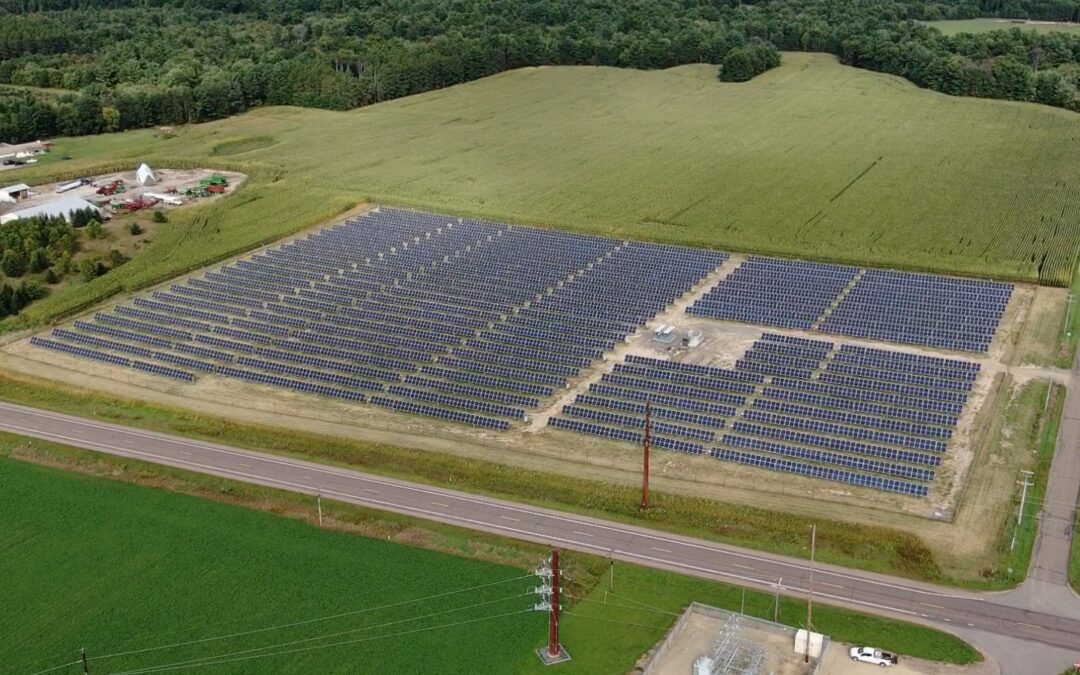
by Michael Vickerman | Oct 27, 2021 | Advocacy, Community, Community Solar, Local Government, Policy, RENEW Wisconsin, Renewables, Solar, Sustainability
For decades, utility investments in power plants and transmission lines have been predicated on the concept of economies of scale. The theory behind it is beguilingly simple: the larger the installation sought by an electric utility, the lower the unit cost of the investment, which utility planners and regulators regard as a measure of economic efficiency. When loads are growing, the “bigger is better” paradigm is often an economically rational fit for electric utilities seeking to recover large-scale capital investments in fossil generation over the broadest possible cohort of current and future customers.
But solar power, the default resource option for electric providers today, is a somewhat different animal due to its scalability. Yes, economies of scale can certainly reduce the unit price of solar generating capacity, but other on-the-ground factors can influence the economics of this resource. These factors include but are not limited to the cost of acquiring site control of the host properties and obtaining all the necessary approvals to construct the project. Interconnection costs can be high as well, especially for larger projects requiring additional land and approvals to supply power to the grid.
These thoughts came to mind after visiting two smaller solar farms that started producing power this year. The first project, called Strobus Solar, was developed by OneEnergy Renewables and serves Jackson Electric Cooperative. The second installation, O’Brien Solar Fields, was one of the stops in this September’s Ride with RENEW bicycle tour. Developed by EDF Renewables and owned by Madison Gas and Electric (MGE), this 20 MW solar farm in Fitchburg supplies electricity to seven MGE customers under long-term contracts.
At a Glance
Solar For the Distribution Grid – 2021 |
| Project name |
Strobus Solar |
O’Brien Solar |
| County of location |
Jackson |
Dane |
| Capacity (in MWac) |
1.5 |
20 |
| Project developer |
OneEnergy Renewables |
EDF Renewables |
| Project owner |
Greenbacker Capital |
Madison Gas + Electric |
| Utility territory |
Jackson Electric |
Madison Gas + Electric |
| General contractor |
Arch Electric |
Boldt Construction |
| Landowner |
Northern Family Farms |
O’Brien Brothers Farm |
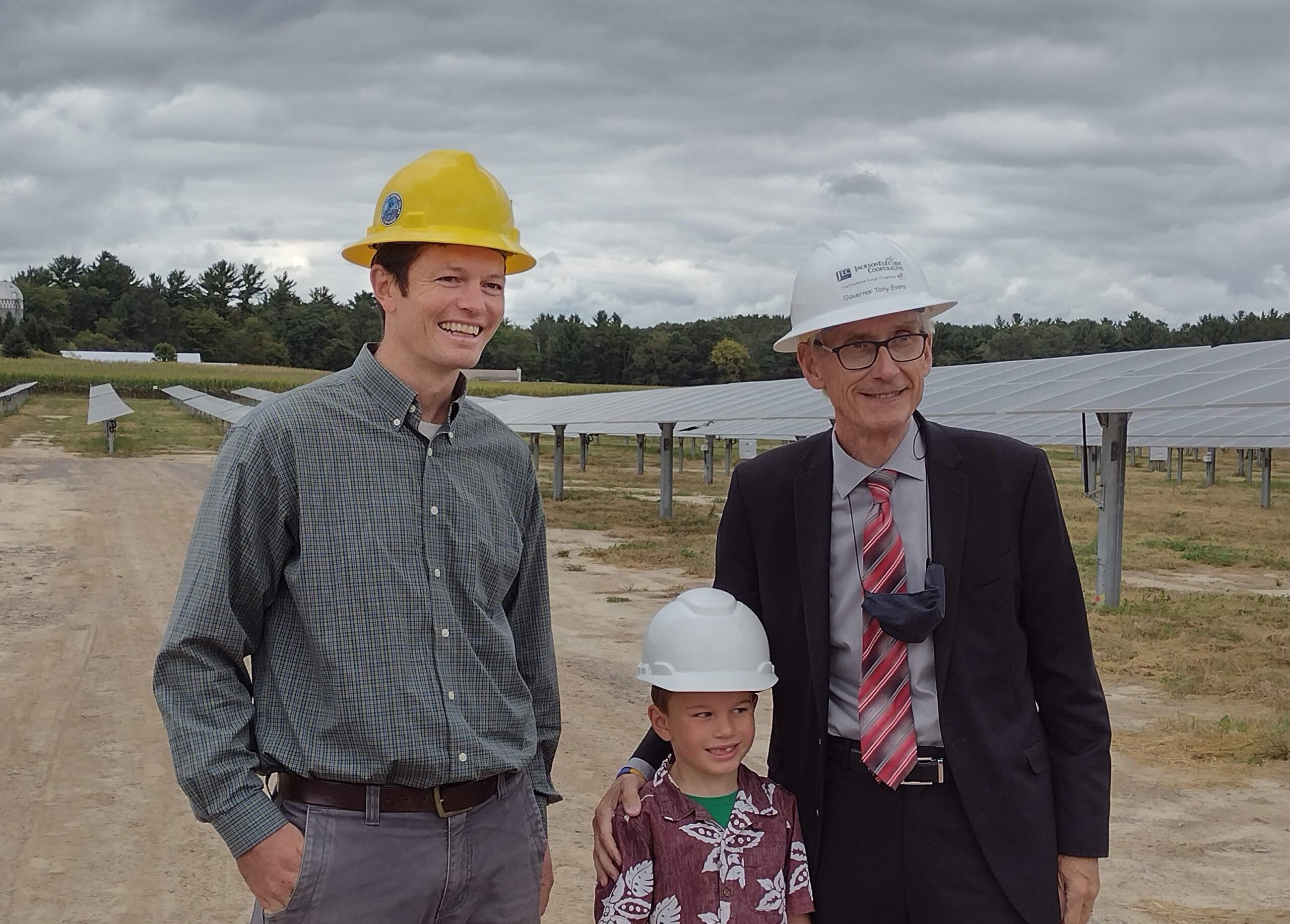 Governor Evers and the Project Developer, Eric Udelhofen, from OneEnergy Renewables at the Ribbon Cutting Ceremony for the Strobus Solar project.
Governor Evers and the Project Developer, Eric Udelhofen, from OneEnergy Renewables at the Ribbon Cutting Ceremony for the Strobus Solar project.
Strobus – A Mastodon Solar project
Occupying a mere 12 acres, Strobus Solar is located about six miles north of Black River Falls and is tucked into a compact parcel framed by evergreen trees and U.S. Highway 12. On a cloudy September day, more than 50 people attended a ribbon-cutting ceremony for the Strobus project, one of eight solar farms in southeast Minnesota and west-central Wisconsin that make up OneEnergy’s Mastodon Solar portfolio. With a combined 17 megawatts (MW) of AC-rated capacity, all eight Mastodon solar farms are located in the territory served by rural electric cooperatives.
As noted on OneEnergy’s website, “the electricity generated by each project will be purchased by the local participating electric cooperative, resulting in savings on energy supply and increased resiliency. These savings will be passed onto the cooperative’s members. The available Renewable Energy Credits will then be sold separately to visionary buyers committed to ensuring their renewable energy procurement dollars are devoted to new projects that serve local communities.”
Of the four Mastodon projects located in Wisconsin, Strobus is the second to be energized this year, following Blue Prairie, a 2.5 MW installation southwest of Black River Falls. The other two, Stromland and Shamrock, should be operating before the end of this year. Plymouth-based Arch Electric is the general contractor for all four Wisconsin projects.
Governor Evers spoke at the ribbon-cutting ceremony, along with representatives of Jackson Electric Cooperative, Arch Electric, and Northern Family Farms, the participating landowner. Based in nearby Merillan, Northern is Wisconsin’s largest Christmas tree grower, operating on more than 7,000 acres. After the prepared remarks, OneEnergy and Arch opened the gates to let Governor Evers and other guests circulate through the project and ask questions.
On one corner of the Strobus parcel is the substation that feeds the solar-generated electricity directly into the wires overhead. Though the equipment onsite is brand-new, low-growing grassy vegetation has already been established, covering the entire project footprint. After three years, the mix of deep-rooted, primarily native plants will provide a healthy habitat for birds, insects, and other species. At nearby Blue Prairie, sheep are already grazing around and under the 7,000 panels installed there.
Strobus is expected to generate about 3,000 megawatt-hours of electricity a year. But the Renewable Energy Credits associated with that output will not flow to Jackson Electric. They will instead be sold to Native, a Public Benefits Corporation, through its New Renewables Portfolio.
According to Native’s website, the purpose of the Portfolio “is to enable Renewable Energy Credit (REC) buyers to play a causal role in actualizing new renewable energy projects. Native has committed to a 10-year renewables purchase agreement with Strobus, LLC on behalf of Portfolio investors. Without this type of long-term REC purchasing agreement, this project would not be economically viable.”
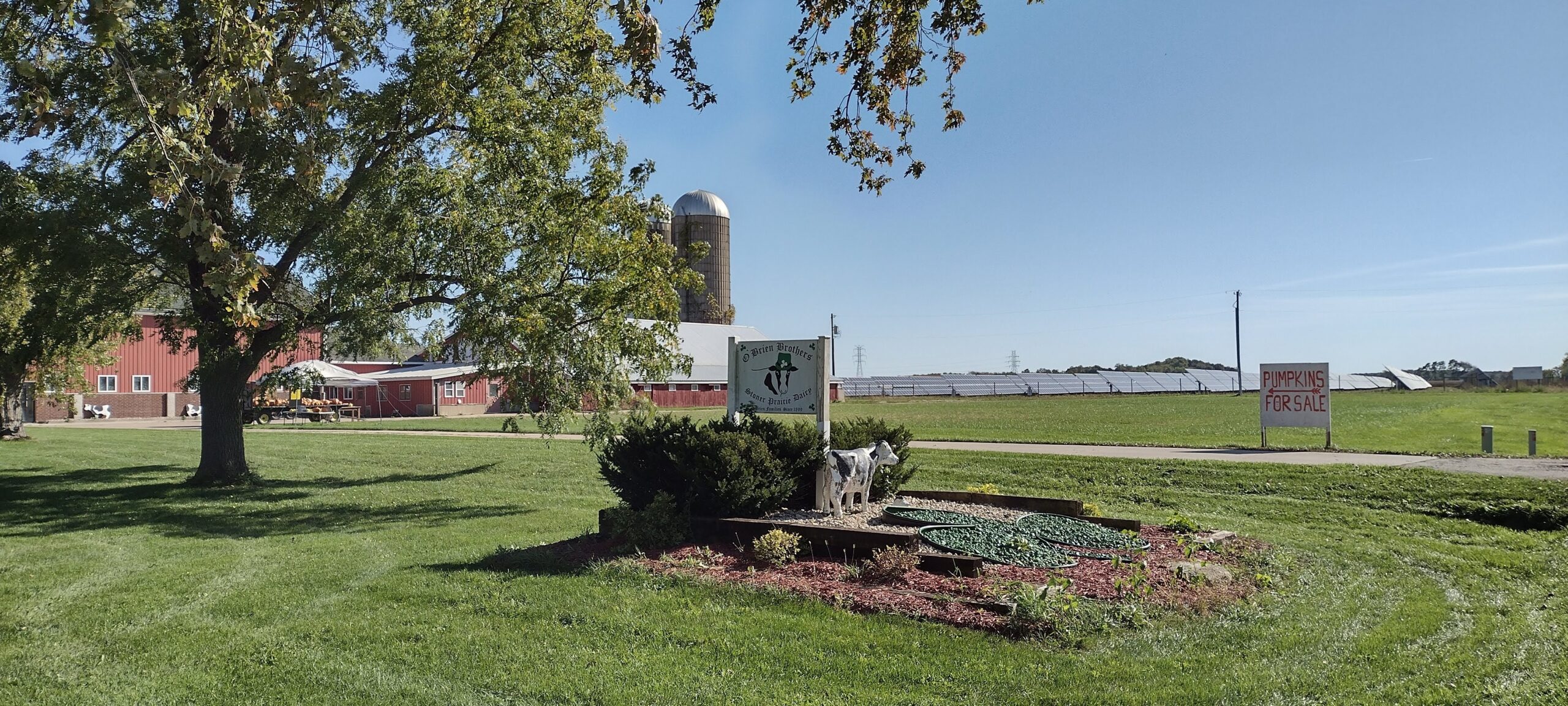 O’Brien Solar Fields in the city of Fitchburg, Wisconsin.
O’Brien Solar Fields in the city of Fitchburg, Wisconsin.
O’Brien Solar – Clean Energy Produced Offsite for Larger Customers
Occupying 130 acres along the edge of urban Fitchburg, O’Brien Solar Fields is as large as a distributed solar project gets. However, while every kilowatt-hour produced at O’Brien flows directly into Madison Gas and Electric’s distribution grid, only seven customers see the impact of this project on their utility bills. Those customers are the State of Wisconsin, University of Wisconsin-Madison, City of Fitchburg, Promega, Placon, Tribe 9 Foods, and Willy St. Co-op.
Energized this summer, O’Brien Solar is the newest Renewable Energy Rider (RER) project serving MGE customers. Several years ago, MGE received approval from the Public Service Commission (PSC) to build solar farms to serve individual customers, including those with multiple facilities, through its RER program. Unique to MGE, this service allows customers to be served by one larger solar farm instead of building numerous solar systems to supply each of their facilities.
A voluntary program, MGE’s RER program does not affect base electric rates. Participating customers fully absorb the cost of MGE’s investment in the solar arrays, and these costs are spread over 30 years. The electricity generated at O’Brien offsets grid power that would otherwise flow to these customers at specified prices throughout the contract term. Should standard electric rates rise faster than the agreed-upon pricing for O’Brien’s electricity, the savings will flow directly to the participating customers.
This unique model combines elements of both behind-the-meter generation and community solar power. But in order to entice customers to access brand-new yet low-cost sources of power, the project owner must design and develop projects that are competitive with the utility’s own avoided cost of power.
The question arises, what did MGE do to keep O’Brien’s development costs in line with its investments in larger solar projects and make it an affordable option for customers?
First, the project occupies only one parcel of land, the former Stoner Prairie Dairy owned and operated by the O’Brien brothers over several generations. Though the parcel is adjacent to a rapidly growing neighborhood, the project’s configuration allows the O’Brien family to maintain its most profitable farming operations as well as live in their long-time residence. Negotiating with only one landowner gives a developer more room in tailoring the project to avoid potentially expensive workarounds.
Second, from an electrical perspective, the project is divided into three zones, each with a separate interconnection to MGE’s feeder lines. By spreading out the project’s output in this fashion, MGE could forgo the more significant expense of running a large tie-in line to the closest substation.
Third, much like a 30-year residential mortgage, the RER contract is a powerful tool for breaking down a significant capital outlay into a manageable expense for the customer. Just as utilities rely on extended depreciation schedules to help them digest the costs of building central station power plants, the RER service provides a similar benefit to participating customers.
In the end, the all-in cost of O’Brien Solar Fields amounted to $29.5 million, which, on a unit basis, comes to $1,475 per kilowatt (kW). To put that number in perspective, the unit price of six larger solar farms totaling 414 MW that Alliant Energy proposes to acquire is $1,449 per kW. In fact, O’Brien’s unit cost is within 10% of the estimated cost of acquiring a 20 MW share of a project ten times as large.
Moreover, it took only three years for EDF Renewables, O’Brien’s original developer, and MGE to advance this power plant from the concept stage to fruition, a relatively speedy turnaround compared with larger solar installations.
Conclusion: The Policy Case for Smaller Solar Farms
Indeed, small solar farms can deliver affordable electricity at a reasonable price by avoiding the increased complexities and additional permitting hurdles associated with larger solar farms that tie into the transmission system. Moreover, while larger solar farms make a great deal of sense in areas rich in transmission infrastructure, relying solely on those locations would exclude much of Wisconsin from being able to host solar power.
There are many parcels of land throughout Wisconsin that have the requisite attributes for hosting projects on the scale of Strobus and O’Brien. In addition, projects of that size are ideal vehicles for community solar offerings, designed to deliver zero-carbon electricity to subscribing customers who cannot access solar power at their residence or business.
Over time, with increases in system power costs looking very likely, the state should explore and adopt policies to promote smaller solar farms within its boundaries. As exemplified by the Strobus and O’Brien projects, development on that scale can yield faster results at comparable costs while potentially providing a reliable revenue stream to the many thousands of landowners who don’t live near high-capacity transmission lines and substations.
Wisconsin is in the beginning stages of an energy revolution. With a more forward-looking policy framework, Wisconsin could emerge as a national leader in solar power. Embracing distribution-level solar solutions now will help more Wisconsinites participate in the benefits of these projects and give every city, town, and village a solar project to call their own. Wisconsin’s population is distributed throughout the state–our renewable energy portfolio should be as well.


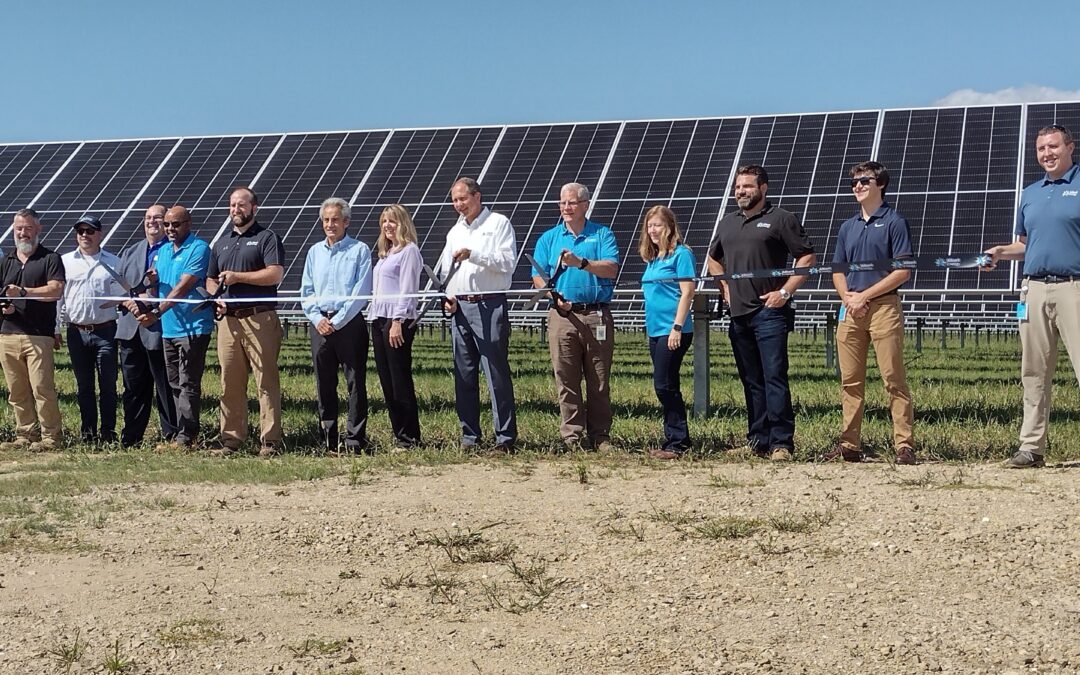
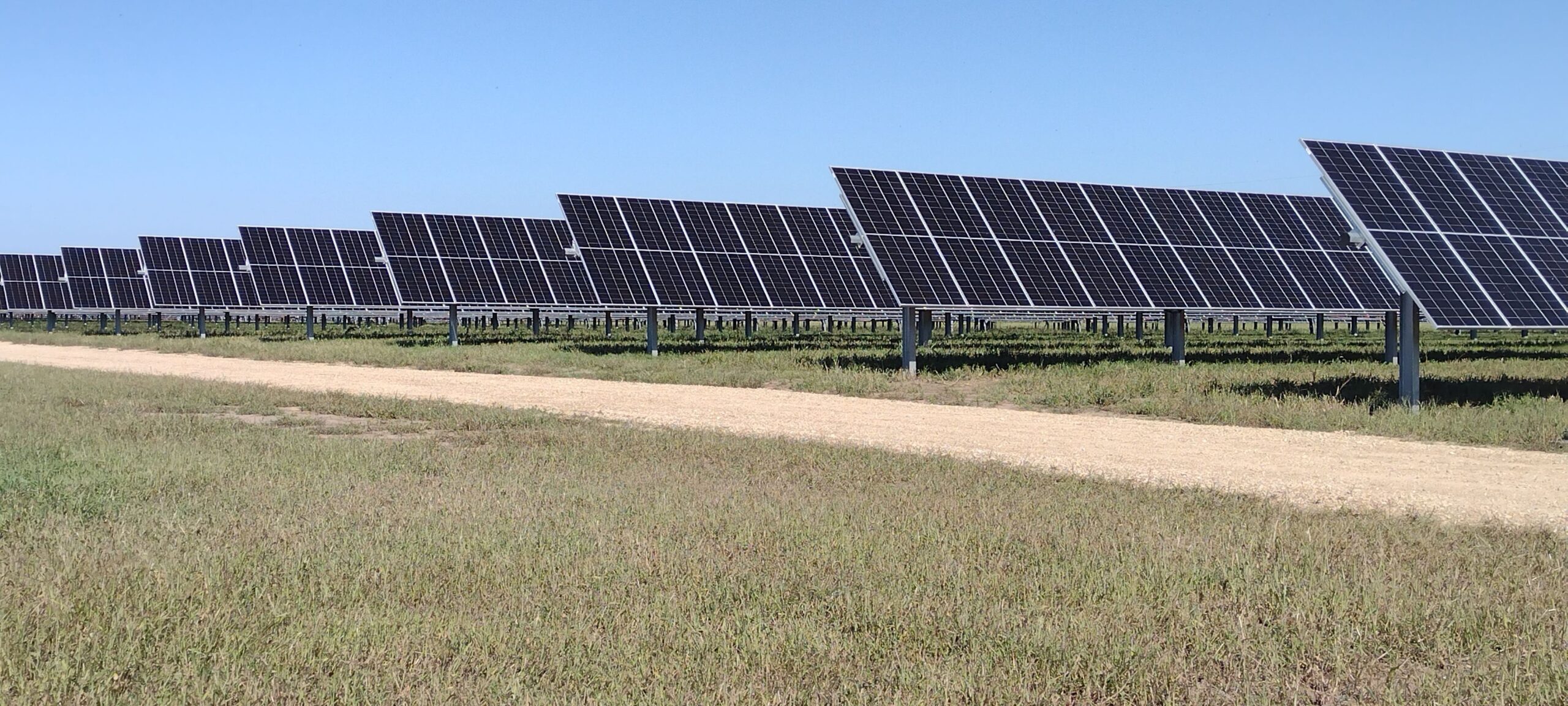
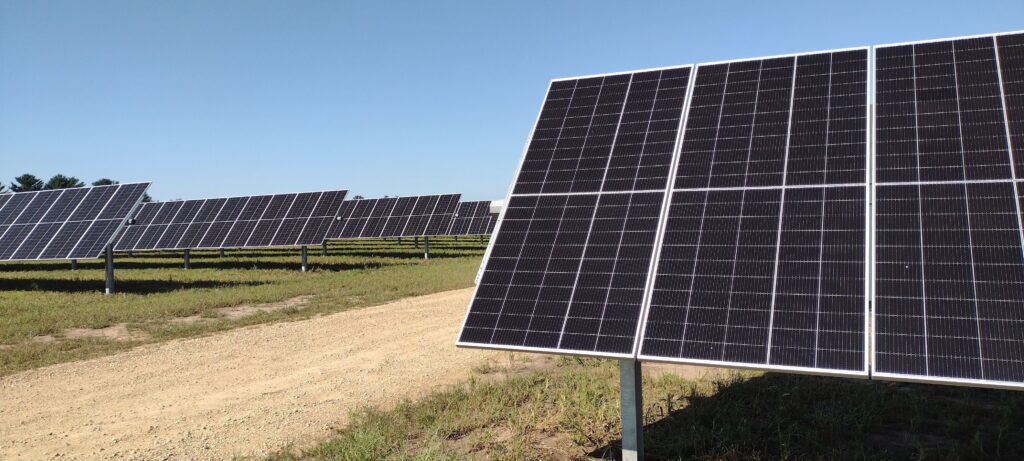
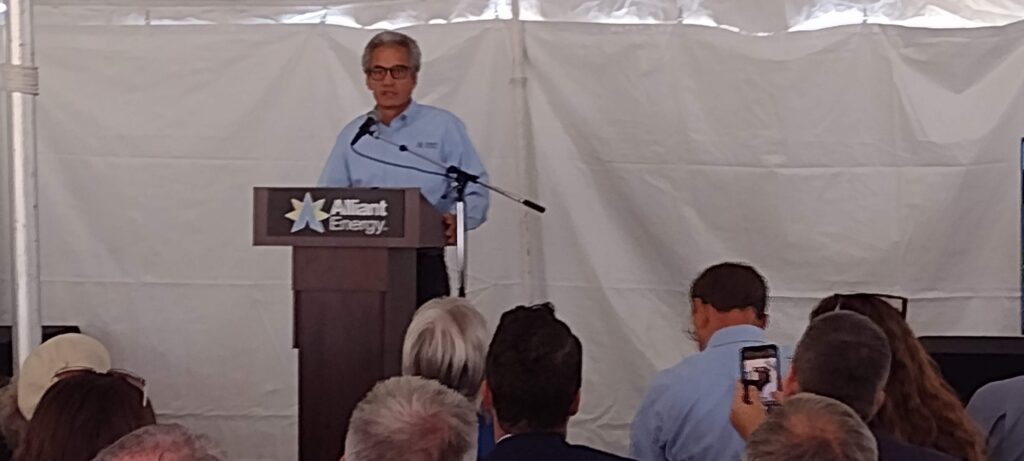
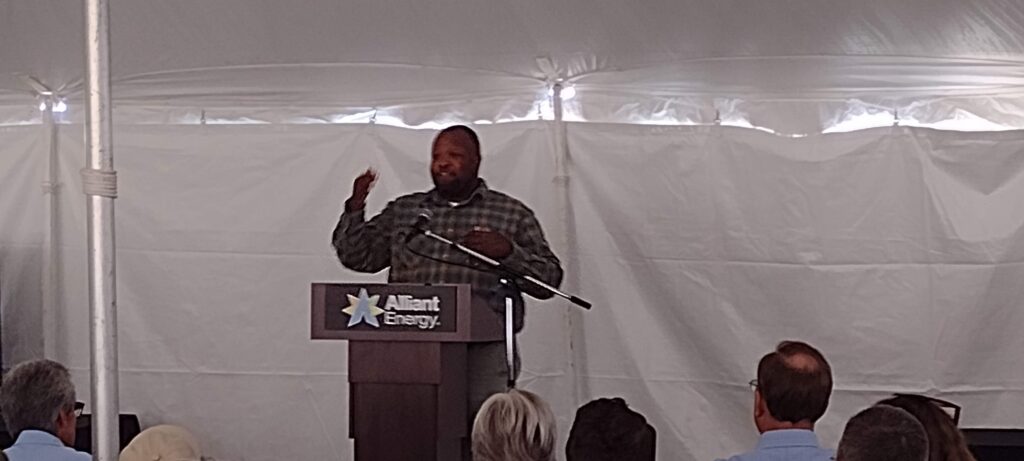
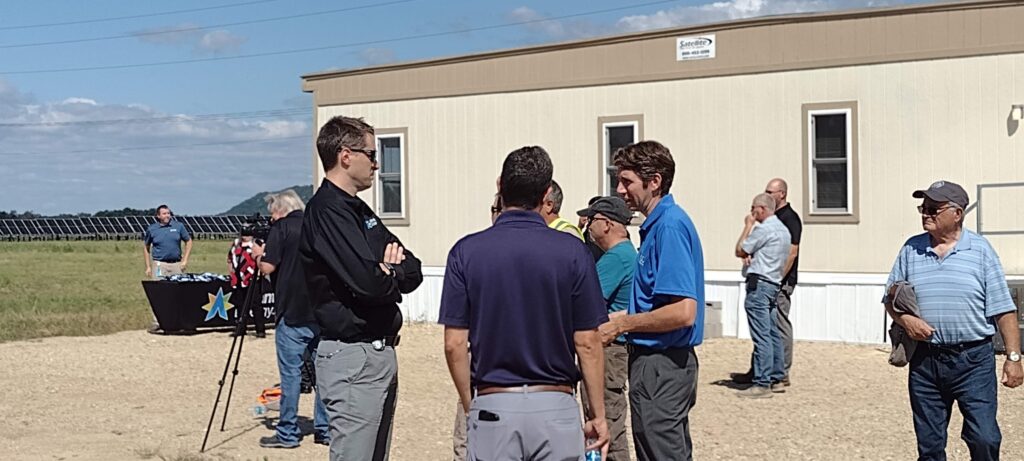
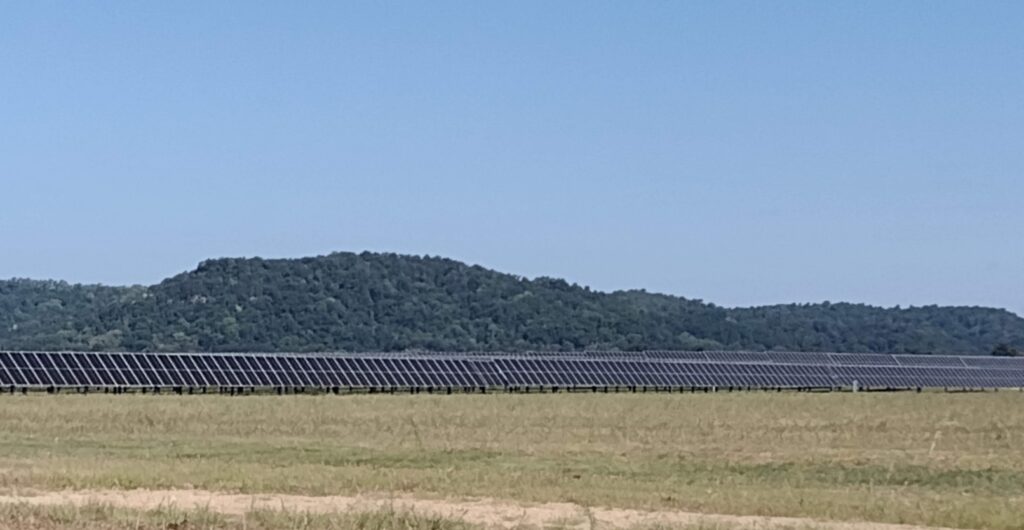
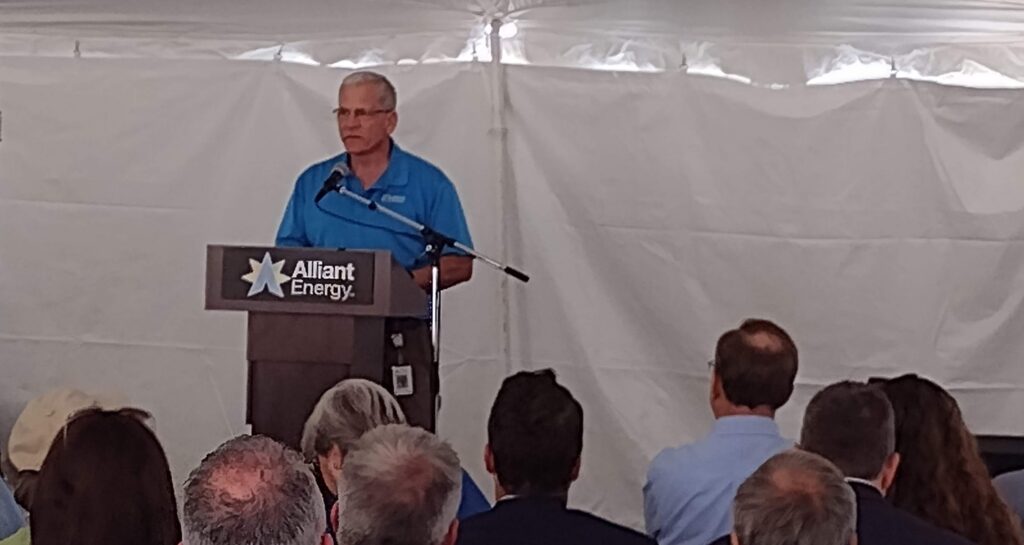
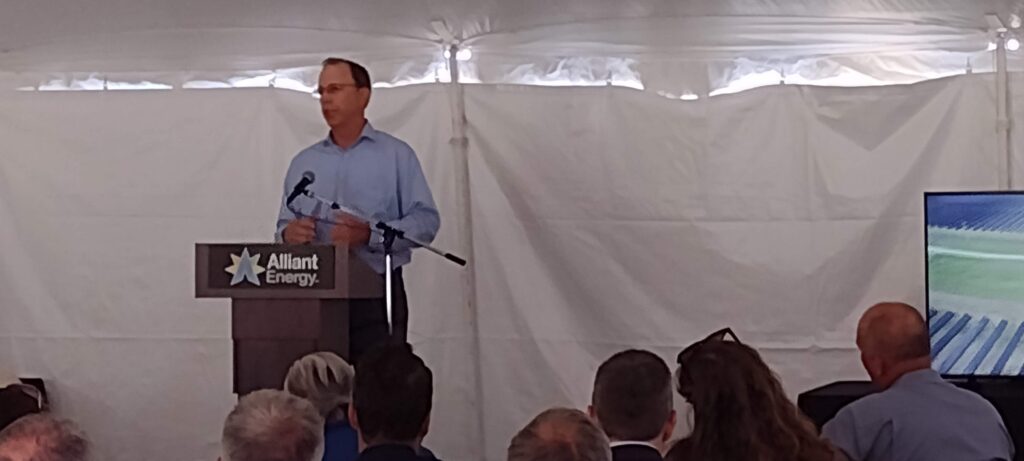






 Governor Evers and the Project Developer, Eric Udelhofen, from OneEnergy Renewables at the Ribbon Cutting Ceremony for the Strobus Solar project.
Governor Evers and the Project Developer, Eric Udelhofen, from OneEnergy Renewables at the Ribbon Cutting Ceremony for the Strobus Solar project. O’Brien Solar Fields in the city of Fitchburg, Wisconsin.
O’Brien Solar Fields in the city of Fitchburg, Wisconsin.